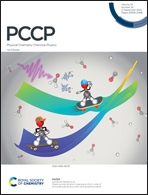Resolving the π-assisted U–N σf-bond formation using quantum information theory†
Abstract
We model the potential energy profiles of the UO2 (NCO)Cl2− → NUOCl2− + CO2 reaction pathway [Y. Gong, V. Vallet, M. del Carmen Michelini, D. Rios and J. K. Gibson, J. Phys. Chem. A, 2014, 118, 325–330] using different pair coupled-cluster doubles (pCCD) methods. Specifically, we focus on pCCD and pCCD-tailored coupled cluster models in predicting relative energies for the various intermediates and transition states along the reaction coordinate. Furthermore, we augment our study on energetics with an orbital-pair correlation analysis of the complete reaction pathway that features two distinct paths. Our analysis of orbital correlations sheds new light on the formation and breaking of respective bonds between the uranium, oxygen, and nitrogen atoms along the reaction coordinates where the “yl” bond is broken and a nitrido compound formed. Specifically, the strengthening of the U–N σf-bond is assisted by a π-type interaction that is delocalized over the C–N–U backbone of the UO2 (NCO)Cl2− complex.



 Please wait while we load your content...
Please wait while we load your content...